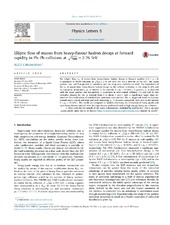Elliptic flow of muons from heavy-flavour hadron decays at forward rapidity in Pb-Pb collisions at \(\sqrt{s_{\rm NN}}=2.76\) TeV
Adam, Jaroslav; Adamová, Dagmar; Aggarwal, Madan M.; Aglieri Rinella, Gianluca; Agnello, Michelangelo; Agrawal, Nikita; Ahammed, Zubayer; Ahn, Sang Un; Aiola, Salvatore; Akindinov, Alexander; Alme, Johan; Helstrup, Håvard; Hetland, Kristin Fanebust; Kileng, Bjarte; Altinpinar, Sedat; Djuvsland, Øystein; Haaland, Øystein Senneset; Huang, Meidana; Lønne, Per-Ivar; Nystrand, Joakim; Rehman, Attiq ur; Røhrich, Dieter; Tambave, Ganesh Jagannath; Ullaland, Kjetil; Velure, Arild; Wagner, Boris; Zhang, Hui; Zhou, Zhuo; Zhu, Hongsheng; Arsene, Ionut Christian; Bätzing, Paul Christoph; Dordic, Olja; Lindal, Svein; Mahmood, Sohail Musa; Milosevic, Jovan; Qvigstad, Henrik; Richter, Matthias; Røed, Ketil; Skaali, Toralf Bernhard; Tveter, Trine Spedstad; Wikne, Jon Christopher; Zhao, Chengxin; Langøy, Rune; Lien, Jørgen André; Alam, Sk Noor; Aleksandrov, Dimitry; Alessandro, Bruno; Alfaro Molina, José Rubén; Alexandre, Didier; Alici, Andrea; Alkin, Anton; ALICE, Collaboration
Peer reviewed, Journal article
Published version

Åpne
Permanent lenke
https://hdl.handle.net/1956/16844Utgivelsesdato
2016-02Metadata
Vis full innførselSamlinger
Originalversjon
https://doi.org/10.1016/j.physletb.2015.11.059Sammendrag
The elliptic flow, \(v_{2}\). of muons from heavy-flavour hadron decays at forward rapidity \(2.5 < y < 4\) is measured in Pb--Pb collisions at \(\sqrt{s_{\rm NN}}\) = 2.76 TeV with the ALICE detector at the LHC. The scalar product, two- and four-particle \(Q\) cumulants and Lee-Yang zeros methods are used. The dependence of the \(v_2\) of muons from heavy-flavour hadron decays on the collision centrality, in the range 0--40%, and on transverse momentum, \(p_{\rm T}\). is studied in the interval \(3 < p_{\rm T} < 10\) GeV/\).\). A positive \(v_2\) is observed with the scalar product and two-particle \(Q\) cumulants in semi-central collisions (10--20% and 20--40% centrality classes) for the \(p_{\rm T}\) interval from 3 to about 5 GeV/\).\). The \(v_2\) magnitude tends to decrease towards more central collisions and with increasing \(p_{\rm T}\). It becomes compatible with zero in the interval \(6 < p_{\rm T} < 10{\rm GeV/}c\). The results are compared to models describing the interaction of heavy quarks and open heavy-flavour hadrons with the high-density medium formed in high-energy heavy-ion collisions. The model calculations describe the measured \(v_2\) within uncertainties.
